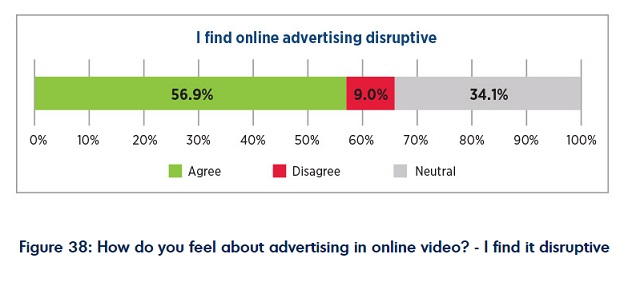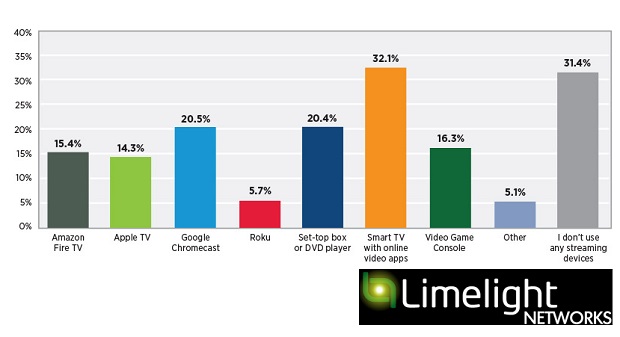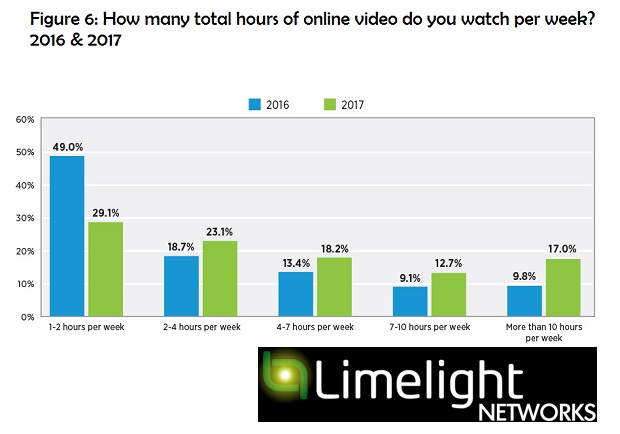Millennial consumers worldwide lead the growing online video consumption, with average global viewership up five hours, 45 minutes per week, according to new research.
The “State of Online Video” research report from Limelight Networks, looks at consumers’ changing viewing habits.
It indicates that the average global viewer watches five hours and 45 minutes each week and subscribes to one or more video on-demand services.
The increasing shift to online viewing is a global trend, with viewers in India, Singapore, and the U.S. spending the most time watching online videos, averaging seven hours, seven minutes, six hours, 37 minutes, and six hours, 35 minutes per week respectively.
Viewers in Europe spend the least time watching online video, with those in the UK averaging five hours, 11 minutes per week. Similarly, those in France watch an average of five hours, four minutes of online video every week. Germany has the lowest rate of online video viewership at four hours, 14 minutes, with almost half of the respondents watching only one to two hours per week.
“With the proliferation of online video content, viewers are moving away from traditional broadcast television viewing and are demanding broadcast-quality online experiences,” said Michael Milligan, Senior Director at Limelight Networks. “Our research over time has shown a clear increase in expectations and decreasing patience with poor quality experiences.”

Additional insight from the report includes:
- Millennials Watch the Most Online Video. Globally, younger people watch the most online video, a trend that is reflected in Europe. In both Germany and the UK, viewers aged 18-25 tend to watch between 4 to 7 hours of online video every week. In contrast, all other age groups in these countries are most likely to watch between 1 to 2 hours. In France, nearly 1 in 4 millennials watch more than 10 hours per week, significantly more than other age groups in France who are all most likely to watch between 1-2 hours.
- The Growth of eSports. Although traditional sports programming was the third most watched type of online video content by men, males 18-25 watch more eSports and online video gaming than traditional sports programming.
- Consumers Won’t Waste Time on a Poor Experience. Rebuffering (when a video pauses during playback to load more content) is the top global frustration when viewing videos online – surpassing poor video quality and limited device access. This is reflected in the U.K. and Germany, where rebuffering was cited as the top frustration by 47% and 38% of respondents, respectively. Interestingly, in France, rebuffering takes second place as the top frustration, with far more respondents choosing poor video quality (46% compared to 31%).
- Smartphones Gain in Popularity for Viewing. Although computers and laptops are the primary online video viewing device globally, they are closely followed by smartphones. These are also fast-becoming the preferred device for millennials – for example, in the U.K., 26% say that more than half of the time, they access video content using their smartphones.
- Cable Subscribers Keep the Cord and Go Further Over-the-Top. Despite cord-cutting concerns, the report uncovered that people subscribing to cable have twice as many over-the-top subscription services than those without cable.
- S. and India Lead Subscriptions to Online Streaming Services. Consumers globally are signing on to streaming with 30 percent of viewers noting they subscribe to two or more services. Subscription rates are highest in the U.S. at 1.67 services and lowest in France, with a subscription rate of 0.71 services. Only 16.7 percent of respondents in France subscribed to two or more services. Viewers in the U.K. and Germany subscribe to an average of 0.93 and 0.83 services, respectively.
- Movies and TV Shows Lead Online Viewing. Globally, viewers spend more time online watching movies than any other type of content. However, viewers in the U.K. watch TV shows most often. When viewed by gender, men prefer movies, while women prefer TV shows.


The “State of Online Video” report is based on a survey of 4,000 consumers ranging in age, gender, and education in France, Germany, India, Philippines, Singapore, South Korea, the U.K., and the U.S.
The complete “State of Online Video” report is available here.
